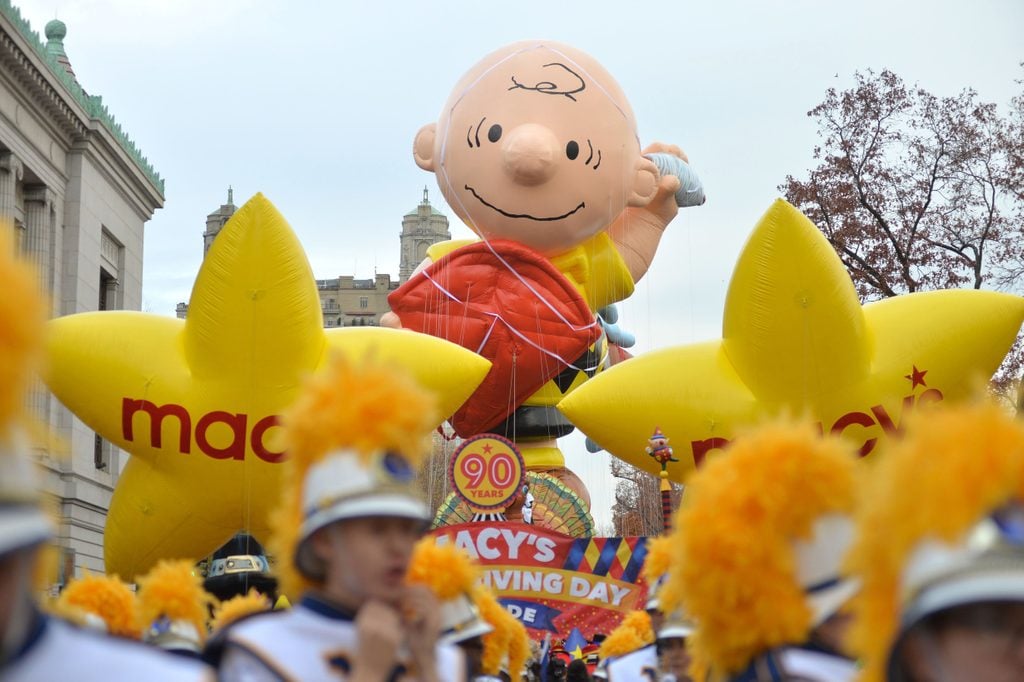12 Incredible Facts About the Macy’s Thanksgiving Day Parade
Updated: Feb. 13, 2024

It's one of America's favorite holiday traditions that kicks off the biggest feasting day of the year. But how much do you really know about the Macy's Day Parade?
Since 1924, people have been delighted by the spectacle of the Macy’s department store’s annual holiday parade. That first year, it was actually called the Macy’s Christmas Parade, held as a promotional event to officially kick off the holiday shopping season. The parade was an instant hit, and in 1927, the name was changed to reflect the fact that it always falls on Thanksgiving. Here’s how to watch the Macy’s Thankgiving Parade this year.
Each year, millions of viewers tune in to the parade while the turkey is roasting in the kitchen (may we recommend any of these incredible turkey recipes for this year’s bird?). But even if you’ve grown up watching the parade every year, there’s probably so much you never knew about its history or behind-the-scenes workings. When you’re sitting around the table this year, pass the sides and start the dinner conversation with these fun facts about America’s favorite parade.
1. It Began as a Veritable Zoo
The first couple years of the parade, from 1924 to 1926, saw handlers marching the route with animals borrowed from the Central Park Zoo. Draped in Macy’s promotional pennants, elephants, donkeys, tigers, camels and bears were paraded down the streets of New York City for the crowd’s enjoyment. However, not everyone was a fan—in 1927, Macy’s decided to replace the creatures with oversized balloon versions, because—imagine this—the live animals scared the children too much.
2. Character Balloons Have Been Around Since 1927
Today, we marvel at larger-than-life Spider-Man, Big Bird and Minions, but the first-ever character balloon was Felix the Cat in 1927. Not only was he the first balloon representing a popular movie character, but one of the first oversized balloons in the parade’s history. Also in that inaugural group: a dragon, an elephant and a toy soldier. And although Felix has returned a few times since his early debut, the character who’s appeared the most is Snoopy, who has been in a total of 40 parades since 1968 and has had seven different designs.
3. Handlers Would Just Let the Balloons Fly Away after the Parade Ended
With no plans to deflate the balloons at the finish of the parade, handlers from 1927 to 1932 would just let them fly away into the air. In the first year of their airborne release, however, the balloons quickly popped after floating high enough. They were redesigned to withstand higher altitudes in the next year, when a new aspect of the parade began.
4. There Was a Race to Capture the Free-floating Balloons
Once the balloons were redesigned, they were printed with a return address, and the race to discover the roving balloons was on. From 1928 to 1932, if you found a balloon and returned it to Macy’s, you’d receive a $100 reward.
5. The Races Ended After an Airplane’s Close Call
In 1932, an aviation student spotted a tom-cat balloon floating at 5,000 feet. Instead of avoiding the balloon, the student rammed the plane into the cat’s neck, getting it caught on the wing and sending the plane careening toward land. Thankfully, the instructor was able to take control of the plane at the last minute, saving them both. After the incident, Macy’s made the call to stop the popular balloon races.
6. Macy’s Is the #2 Consumer of Helium in the World
Large balloons take about 12,000 cubic feet of helium to become fully inflated, meaning Macy’s needs a huge reserve for its stable each year—the second-largest reserve, in fact, after only the U.S. government.
7. Parade Organizers Got Crafty During a 1958 Helium Shortage
That year, there was a strong possibility the parade would have no balloons at all. Fortunately, the parade’s organizers came up with an idea to fill the balloons with regular air, then hang them from large cranes that slowly toted them along the route.
Take a look at floats and balloons through the years in our album of vintage Macy’s Thanksgiving Day Parade photos.
8. It Takes a Long Time to Inflate Those Mega Balloons
Each large balloon needs about 90 minutes to be inflated. But it only takes 15 minutes to deflate (thanks to strategic deflation vents and the ol’ lay-on-it-and-roll method that balloon handlers employ at the end of each parade).
9. The Parade Was Canceled During World War II
From 1942 to 1944, Macy’s canceled the parade. The store put those balloons to good use, though, deflating them and donating the 650 total pounds of rubber to the U.S. government for use in the war effort.
10. The Person in Charge of Each Balloon Is Called a Balloon Pilot
The balloon pilot’s job is to walk in front of the balloon and direct the rest of the handlers on how to navigate the route. To become a pilot, a candidate for the job must be able to walk the entire 2.5-mile route backward, without stumbling. Macy’s offers balloon pilot training three times a year to prepare for the big day.
We’re tired just thinking about it! Get some pep in your step with these impressive Thanksgiving desserts.
11. And the Ropes They Hold? They’ve Got an Interesting Name, Too
Up to 90 people are needed to anchor and navigate each balloon, and they do so by grasping onto long ropes affixed to the bottom and sides. These ropes are called “bones,” and they require a specific way of handling so they remain taut throughout the parade.
12. Balloons Are Purposely Designed to Fit Through the Lincoln Tunnel
Each balloon is designed and stored in the Macy’s Parade Studio in New Jersey. To make it to the beginning of the parade route in Manhattan, the balloons have to travel through the Lincoln Tunnel, meaning they must be able to pack down to 12.5 feet high and 8 feet wide. To enable this, each balloon is designed in pieces, which can easily fold up and fit into boxes for transport.
Aside from the traditional Thanksgiving recipes you look forward to all year, the Macy’s Thanksgiving Day Parade just might be the most beloved part of the holiday. From featuring live musical productions to the world’s biggest pop stars taking the stage, the parade’s come a long way. But it’s always fun to look back and remember its roots, and how the icon has become what it is today.
